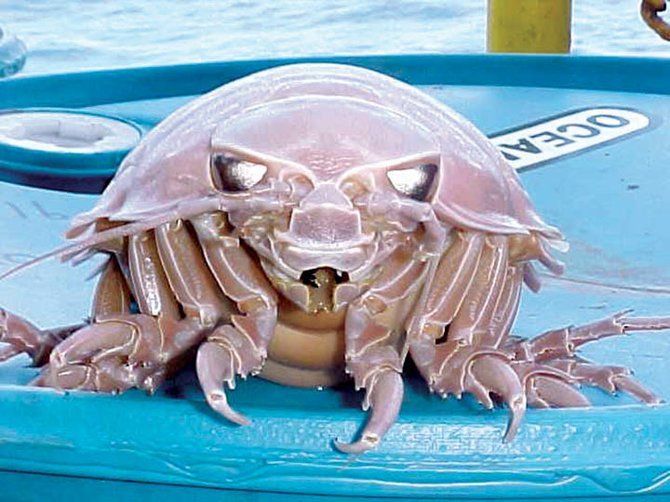SCIENTISTS at the Cape Eleuthera Institute received the shock of their lives when they discovered that the teeth marks that almost gnawed through the cables of an underwater camera system belonged to a massive woodlouse.
Staff member Ed Brooks said he is sure a woodlouse whose scientific name is the Bathynomus giganteus was behind the attack.
“There is nothing else with mandibles that sharp. It was a Bathynomus attack,” he said.
The Bathynomus, which lives 8,500 feet underwater and grows more than a foot long, is a supersized cousin of the woodlouse.
Classified as a giant ispod, the Bathynomus legs are arranged in seven pairs and its front two are able to manipulate and eat through four sets of jaws.
According to SeaPics.com, the Bathynomus giganteus, is the largest member of the isopod family, a group of crustaceans closely related to shrimps and crabs. It is carnivorous and is a valuable scavenger, eating from the deep sea floor whatever falls from above, including bodies of whales, fish, and squid. It may also feed on slow-moving sea cucumbers and sponges. Food is scarce in the deep ocean, and they are adapted to long periods of famine, and will gorge when food is plentiful.
Giant isopods are found in most oceans of the world. Their habitat ranges in depth from 550 feet to 7000 feet, living solitary lives on mud or clay ocean bottoms. Their huge size is caused by deep sea gigantism, where deep ocean creatures grow to a much larger size than their shallow water counterparts, believed to help deal with the enormous pressures at deep sea floors. The giant isopod can grow to a length of over 16 inches, and has a hard shell that is divided into segments that make it both strong and flexible – it can roll into a ball to protect its soft underside, similar to pill bugs found on land. The giant isopod has compound eyes, with over 4,000 individual facets, and large antennae to help it find its prey in the dark reaches of the ocean. It has a complex mouth with many components to help it catch and shred its food.





Comments
Mayaguana34 11 years, 10 months ago
LOL - free news and great attention for our marine life and of course the cape eleuthera marina - nothing significant about the incident and the find - But I love reading about this often neglected aspect as to who we are and our 100k sq miles of marine habitat
242 11 years, 10 months ago
I love it
John 11 years, 10 months ago
Scientist.."shocked" by a marine creature living in its normal habitat, living like it is supposed to and everything else aboout it seems normal, but scientists are 'shocked'. Maybe they have been hearing about the Nassau murders and crime wave for too long for everything else to be normal.
alissa337 11 years, 10 months ago
Come on people! "shocked," as in electrical shock...
eddbrooks 11 years, 10 months ago
I wasn't particularly "shocked" - but I guess that doesn't make for an exciting news article! Check out a more comprehensive write up of our current deep water project http://www.tribune242.com/news/2012/j...">here and an older one http://www.thebahamasweekly.com/publi...">here. A video of all of the amazing deep water animals - not just the bathynomus - found during this pilot project can be found http://www.youtube.com/watch?v=e4ecOl...">here.
Sign in to comment
Or login with:
OpenID